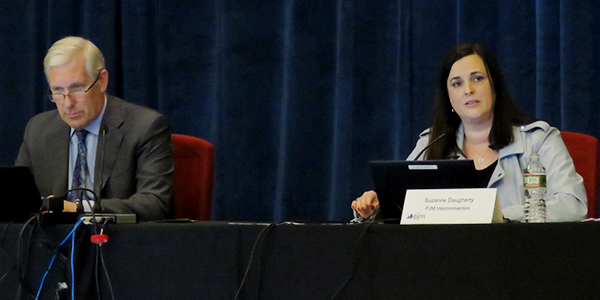By Christen Smith and Rich Heidorn Jr.
Markets and Reliability Committee
Revisions on Incremental Capacity Transfer Rights Endorsed
WILMINGTON, Del. — The Markets and Reliability Committee on Thursday endorsed a change to align PJM’s Tariff with manual language on the process for requesting incremental capacity transfer rights (ICTRs) calculations.
Steve Herling, PJM vice president of planning, said the “very limited” change requires new service customers to request the calculations during the facilities study phase and limits each request to no more than three locational deliverability areas.
The change comes in response to a FERC order that found PJM had not been following section 234.2 of the Tariff for assigning ICTRs. The RTO had clarified the procedure in Manual 14E: Upgrade and Transmission Interconnection Requests, but FERC said it must also be added to the Tariff (EL18-183).
The Tariff requires the RTO to identify the increase in the capacity emergency transfer limit (CETL) resulting from an interconnection, merchant transmission facility or customer-funded upgrade.
“As a practical matter, it would be impossible for us to calculate the increased CETL for every generator in the queue,” Herling said, citing estimates that it would take 54 hours per case to study deliverability to all 27 load delivery areas. “Bottom line is, for us to keep putting out system impact studies in compliance with the Tariff, we have to make to a change. Either we will have to stop putting out studies, or projects will be significantly delayed.”
The MRC on first read unanimously endorsed the change, which also was approved unanimously by the Members Committee later Thursday.
Fuel Security Issue on Tap for Feb. MRC
PJM will present the first read of a problem statement and issue charge on Phase 2 of its fuel security initiative at the February MRC, with a vote targeted for March, PJM’s Tim Horger said.
The RTO will recommend assigning the issue to a new senior task force reporting to the MRC. Among the issues to be discussed will be attributes that define a fuel-secure resource, whether a minimum quantity of fuel-secure resources is necessary, and market and operational mechanisms that could ensure fuel security.
Horger said PJM will be seeking a market-based solution, potentially through changes to the capacity market.
In mid-January, the RTO published 324 scenario templates from the fuel security analysis it released in December, which concluded that it should take “proactive measures” to value fuel security attributes of its generators.
The analysis found that “on-site fuel inventory, oil deliverability, availability of non-firm natural gas service, location of a pipeline disruption and pipeline configuration become increasingly important as the system comes under more stress.” (See Full PJM Study Makes Case for Fuel Security Payments.)
The RTO hopes to make a FERC filing in December or early 2020, Horger said.
The issue is likely to spark a renewed battle between supply and load interests. Tom Rutigliano, representing the Natural Resources Defense Council, said the issue should first be dealt with under the Capacity Performance program, noting that many risk factors listed in PJM’s analysis are unit-specific and thus part of generators’ CP obligations.
Although PJM acknowledged no individual generator could address systemic risks such as pipeline breaks or cyberattacks on supply systems, “the risks found in their study are mostly interruptible fuel contracts and lack of trucks, both of which can be solved by individual generation owners,” Rutigliano explained later. “Pipeline breaks play a relatively small component in the study results.”
Manuals Approved
The MRC unanimously endorsed the following manual changes:
- Manual 38: Operations Planning: Periodic review and update to procedures.
- Manual 40: Training and Certification Requirements: Cover-to-cover periodic review.
- Manual 14G: Generation Interconnection Requests Planning Process: Cover-to-cover review.
PJM’s Adam Keech also notified members of a change made earlier this month to Manual 11: Energy & Ancillary Services Market Operations to clarify the current procedure regarding transient shortage pricing.
Keech said the manual did not fully describe the process for determining reserve shortages. He said the RTO became aware of the issue following a July 10 incident in which its area control error fell to -2,942 MW with a low frequency of 59.903 Hz.
PJM determined the low frequency resulted from several causes, including multiple unit trips, non-approved cases from real-time security-constrained economic dispatch and poor synchronized reserve response.
Members Committee
Members approved a revised definition of “on-site generators” in the market participation rules in the Tariff and Operating Agreement. The new definition recognizes that behind-the-meter resources can participate as both demand response to reduce load and as generation to inject power.
FTR Mark-to-auction Credit Requirements OK’d
With one objection, the committee approved a new a mark-to-auction component for financial transmission rights credit requirements, a change prompted by the GreenHat Energy default.
Although a decline in market value can indicate increasing FTR risk, PJM’s rules do not provide for a collateral call when an FTR portfolio’s value is deteriorating. The change would consider the difference between the FTR purchase price and most recent market price. It cleared the MRC in December. (See “FTR Collateral,” PJM Market Implementation Committee Briefs: Dec. 12, 2018.)
Opportunity Cost Calculator Manual Revisions
Members endorsed revisions to Manual 15: Cost Development Guidelines governing generators’ use of the Independent Market Monitor’s calculator as an alternative method of calculating energy market opportunity costs.
A vote on related revisions to Schedule 2 of the OA was deferred again, until February. (See “Opportunity Cost Calculator Vote Deferred,” PJM MRC/MC Briefs: Oct. 25, 2018.)
Liaison Committee Meetings to Change
Members heard the first read of a charter revision that would require the scheduling of Liaison Committee meetings with the Board of Managers before the board’s regular meeting. Under current rules, Liaison Committee meetings alternate between before and after the board meeting. The change came out of discussions at the Stakeholder Process Forum.






